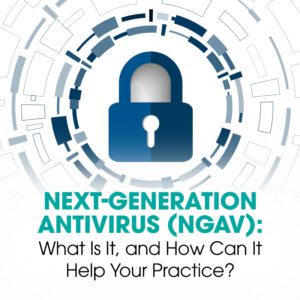
Veterinary IT Security Standards of 2023
The IT Security Landscape has changed dramatically over the past 3-6 years. What it took to protect a Veterinary Practice in 2016 just doesn’t work in 2023. It’s time to ensure you have the next generation of protection in place to assure you don’t fall victim to a massive attack, data breach and extreme down time.
The first major change is making sure you are protected by “Next Generation Antivirus” protection, “Next Gen AV” for short. This new solution uses a combination of artificial intelligence, behavioral detection, machine learning algorithms, and exploit mitigation, so that known and unknown threats can be anticipated and immediately prevented. Legacy AV of the past (2016-2020 solutions) just don’t work and can be sidestepped by a hacker very easily.
In the past, security companies compiled a database of known attacks and code that could be used against an endpoint, often cataloging what were called ‘signatures’ that are associated with specific types of malware to detect and prevent these attacks. But the “Bad Actors” (what we call hackers) have many more sophisticated approaches that find ways right around these legacy AV defenses!
So how do you know if you are using the Next Gen AV Solution? Ask! Your IT Partner should be able to discuss what they have in place to keep you safe and whether their AV solution is classified as Next-Gen AV or not. Have them prove to you that the product has prevention of both Known and Unknown Malware. Ensure this solution is cloud managed and monitored to assure if/when any detections occur they are being reviewed and remediated.
2022 saw the rise in prominence of what we call Endpoint Detection and Response (EDR) tools. Prevention techniques like AV, patching of your computers, software updates, etc. all are important but what we call a prevent strategy. When meeting with Veterinary Practice Managers and Owners, we often use the following comparison to make it easier to understand: Prevention is like locking your windows and doors to your Practice when you leave at night. Ensuring things are locked prevents quick and easy access into your building, keeping the Bad Actors from being able to easily open a door or window for access.
Some Veterinary Practices subscribe to a Security Service like ADT or similar company. They place sensors on doors, windows and even have motion detection and video cameras in place. This keeps a watch over your clinic or hospital and would alert this company should an intrusion occur so that a quick response to this intrusion can occur and possibly mitigate damage to a minimum.
This is what an EDR solution is. It is like an alarm system for your computers and networks. This paired with a Next-Gen AV would allow quick detection of any issues. It watches for “motion” a Bad Actor makes, or what we call a lateral attack move. It can detect if someone is in and isolate that computer or device so that it can NOT attack any other devices on your network. This allows your IT Security Partner to respond to the attack and get a good indication of how the attacked occur.
Next-Gen AV and EDR solutions form the backbone of the IT Security standard for 2023. More and more insurance companies are requiring this solution be in place to be able to offer Cyber Security Insurance. We highly advise veterinary clinics and hospitals ensure they have these new 2023 security requirements in place. We are seeing a huge spike in attacks recently and most of the veterinary practices we review are relying on old, outdated technology from years past.
Need help assuring your Practice is protected. Contact us today for a FREE Security Assessment
